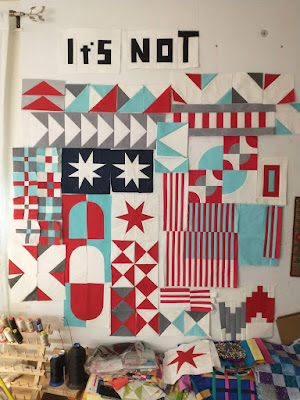
- USE: How will the quilt be used? What is it for? Will it’s purpose be art or utility? Do you want a wall quilt, throw quilt, or a quilt for your bed? This will help you determine a size for your quilt.
- COLOR: Are you happy with the color palette you’ve been using? Do you want to make changes, such as adding more of a certain color or print? Perhaps you’d like more neutrals? Or more pops of color? Maybe the colors in one particular block look out of place with the other blocks. You could choose to leave the block out or to make additional blocks using some of those same colors to balance out your palette. Or, if your palette seem too static, you could add small bits of a contrasting color to some additional blocks, or to fill in blank areas.
- SCALE: The sizes of the blocks over the past eight months (when specified) have varied. This was intentional in order to add a level of challenge to the final quilt assembly, and individuality to each design. This is not a cookie cutter pattern. It’s not really a pattern at all, but a set of varied ingredients waiting to be compiled into a quilt that is entirely your own. In order to make it work, you may want to make some blocks larger and some smaller to suit your vision. It could be an interesting design decision to vary the scale of one block and include several different sizes in your quilt. The varying block sizes also allow you to consider how big you want your quilt to be and which blocks you wish to rescale.
- BALANCE: As you consider different block layouts and quilt designs, pay attention to the visual weight of the shapes, colors, and spaces. Are there places where your interest is drawn and your eyes naturally rest? Do any parts of the layout feel overpowering? Being intentional about areas of focus can help to balance your design. You may be more comfortable with a central focus, or one that is asymmetrical with several focus areas spread across the composition. There is not a single formula that works for everyone or every set of blocks.
Where/How to Start:
Lay out all the blocks you have made so far. What do you like and not like? Is something calling to be the central focus. What kind of quilt do you picture? Perhaps a regular grid made of one or two repeating blocks? Or a sampler using many different blocks? How about a medallion style quilt with a central area and expanding borders surrounding it? Think about use, color, scale, and balance, as outlined above. Snap a photo of what you have so far.

Next, move your blocks around to see if any patterns emerge. You might notice a new focus that you like more than the first arrangement. Continue to place and rearrange blocks to make a totally different layout. If you don’t have enough blocks, just pretend and leave some blank areas equal in size. Or, if you have the time, go ahead and make more blocks now. Continue to take photos as you go along and as your design changes and grows. By capturing your steps throughout this process, you can always go back to a previous arrangement or earlier design you liked better.

Try grouping the similar blocks in different ways. If you line up like blocks into rows, or group them into distinct sections, how does it change the dynamic? Can you see other patterns emerging? Consider going beyond horizontal and vertical rows, and try diagonal arrangements. Continue to think about color, scale, and balance. Remember to stop and take a photo of each new configuration.

blocks, if needed.
Put your plan into action:
Hopefully all of this rearranging and thinking and experimenting will lead you in a clear direction, and now you can work on filling in the blanks needed to make your design work. You will likely need to make additional blocks (see links to previous months’ posts below). Don’t be afraid to make more blocks than you need — you can always use them for part of another quilt or in a pieced back. Spend some time making blocks and fine-tuning your design. Continue to consider color, scale, and balance as you work. If you wish, share your progress on social media with the hashtags #chicagomqgsewalong and #BFMSAL. Pay attention to the evolution of your design, and enjoy the process!

And it needs more blocks for repetition and size.
